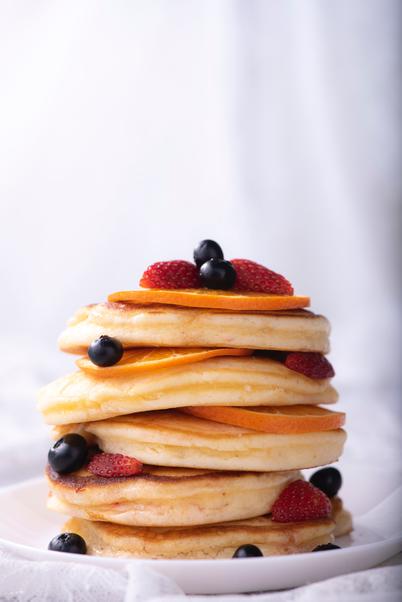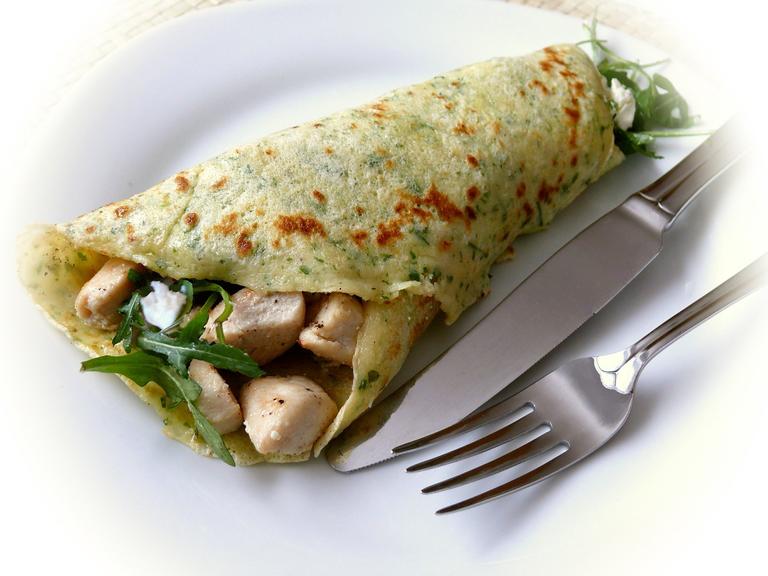Pancake Tuesday is up on us once more. Besides being a delicious and hearty breakfast choice, they are also very simple to make:
on us once more. Besides being a delicious and hearty breakfast choice, they are also very simple to make:
Whisk together eggs, flour, and milk in a bowl. Add it to a hot frying pan. Cook until one side is golden brown, flip it over and cook the other side. (Or stick it under the grill to cook the top)
Regardless of your preference, there are ways to enhance their nutritional value.
Here we're going to look at 5 ways of making your pancakes healthier.
1. Reduce Sugar
Sugar and lemon juice are the humble toppings for a pancake. While a little sugar every so often isn't going to do any harm, high amounts of sugar can raise your risk of diabetes and heart disease.
Stevia sweetener is a plant extract which looks and tastes like sugar, but without the calories. You would only need a light sprinkle of this powder on your pancakes, as it's touted to be 200x sweeter than sugar.
In place of golden syrup or honey, you could try agave nectar. This syrup has gained popularity as a healthier alternative to sugar. It's lower in calories and contains fewer carbohydrates than honey.
Both stevia and agave nectar are available from most supermarkets and health food shops.
If you typically add sugar to your pancake batter, try substituting it for granulated sweetener or omitting sugar altogether from the recipe.
2. Fruit
Fruits are nature's sweets. They can drastically improve the taste of your pancake without adding many calories.
Throw a handful of blueberries into your pancake batter after you've poured it into the pan. Berries are packed with nutritious fibre and vitamins, which are essential for maintaining your body's health.
Top your pancakes with raspberries or blackberries for a touch of added tang. If you prefer something sweeter, try strawberries or dried fruits like raisins, dates, figs, or prunes.
Banana also goes excellently with pancakes, whether you use it as a topping or as part of the batter - we'll get onto that shortly. The long, yellow fruit is packed with potassium and fibre, while also being easy to digest. Try pressing some banana with a fork, adding a pinch of cinnamon and filling a pancake with it.
3. Savoury options
Who says pancakes have to be sweet?

Savoury pancakes can help you drastically reduce the amount of sugar and increase your daily intake of protein, vitamins and fibre.
Try adding a poached egg with some grilled bacon for a breakfast pancake. Eggs are packed with protein, and grilled bacon (as opposed to fried bacon) contains less saturated fat.
Chicken and mushrooms can also make for a protein-packed pancake filler. Add some spring onions and garlic for extra flavour. Similarly, ham and cheese can be an excellent dinner idea for pancake day.
Add spinach or rocket leaves for extra iron, chillies for heat and bell peppers, which are loaded with vitamins, for crunch. You can also add herbs and spices to the batter to make it more flavourful.
4. Low-fat oil
All that glistens is not gold; it's fat. Saturated fats are common culprits in cases of high cholesterol and can be easily replaced with healthier alternatives. Butter and lard contain more saturated fat than olive oil and contribute to raised LDL (bad) cholesterol levels.
Instead of butter or even vegetable oil, try rapeseed oil. Rapeseed oil is packed with omega-3 and antioxidants, making it a much healthier alternative to other oils. It also contains more polyunsaturated fats than olive oil, which can help to lower your cholesterol.
If you can't get hold of rapeseed oil, there are always sprayed oils. These simply cake the pan with less oil than if you were to add a knob of butter or pour some oil straight into the pan. You'll often see a spray oil with a label such as "1kcal per spray", which can help people who are counting calories.
Both spray oils and rapeseed oil are available from a variety of supermarkets.
5. Banana pancakes
Banana pancakes require 2 ingredients - eggs and banana. They are low-fat, packed with protein, and dairy-free.
You will need 2 medium eggs and 1 banana. (This recipe makes 4 small pancakes)
For the best results, preheat a small frying pan before making up the pancake mixture.
Start by mashing 1 large peeled banana using a dinner fork into a bowl. You should aim for about half a cup of mashed banana. Aim for a smooth consistency, though it's fine if there are a few lumps.
If you want to add cinnamon, vanilla extract or cocoa powder, add it to the bananas before adding the eggs. Don't add chocolate chips or any heavier ingredients until the pancake mixture is in the pan.
Break two eggs over the mashed banana and lightly beat them into a loose liquid. The mixture will be thinner than normal pancake batter.
To make your pancakes fluffier, add a pinch of baking powder to the mixture.
Add some oil to a hot pan and slowly pour a small amount of the pancake mixture into the frying pan. It's important to only make small pancakes (between 3 and 4 inches in diameter) using this pancake mixture, as bigger pancakes will break apart.
Cook the bottom until it is golden brown.
To flip the pancake, slowly peel up one edge and tip the pancake over in a smooth motion. Be careful, as this pancake mixture is delicate and prone to breaking when you flip it.
If you struggle with flipping, you can remove the frying pan from the hob and cook the top using a grill (broiler).
Once the other side is golden brown, remove it from the heat. Top your pancake with fresh fruit, yoghurt, syrups, honey or whatever you like.
Bonus: Yoghurt or sorbet instead of ice-cream
Ice cream and pancakes are a common sight on restaurant menus. While it's fine every now and again, there are healthier options to this popular dairy delight.
Sugar-free, plain or Greek yoghurt can be a great addition to pancakes, especially when combined with fruit or honey. While yoghurt contains a lot of saturated fats, it also contains a moderate amount of mono-unsaturated fats, which are actually quite good for you.
If yoghurt isn't your thing, try sorbet! Sorbet is essentially frozen, pulverised fruit. You can make it yourself at home by blending fresh fruit with juice or water and freezing it. You can also buy sorbet from some supermarkets and health food shops. A scoop of sorbet will have about half the calories as the same amount of ice cream.
No matter how you like your pancakes, there are ways you can make them more nutritious, from toppings and fillings packed with vitamins, protein and fibre, to changing how you cook them.






